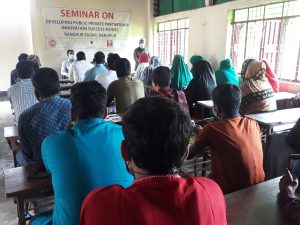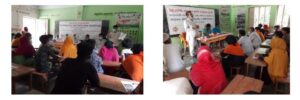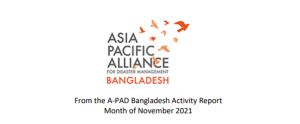
A-PAD Bangladesh Activity Report Month of December 2022
.
Project Title: Capacity Building Project for the Establishment and Sustainable Management of a Multi-Sector Platform for Disaster Management in Bangladesh
Project Period: 17 January, 2022 – 16 January, 2023 (12 month)
- Project Activities and Accomplishments
Bangladesh is one of the hazardprone countries in South Asia. Floods, droughts, landslides, thunderstorms, hurricanes and cyclones occur regularly. Among these earthquakes, floods and drought risk are extremely high. These hazards threaten millions of lives and cause large scale financial, infrastructure, agriculture and productivity losses that seriously hinder Bangladesh’s overall development. Bangladesh has limited resources and lack their own disaster management plans. Considering these problems, this paper attempts to throw light on a more integrated and responsive disaster management system in Bangladesh. Disaster Management approaches in Bangladesh harmonizing systematic inquiry of Disaster Management in Bangladesh is not well conversant in the available literature. Moreover, this approach taken from different programs at national, international and community level, which is not redeveloped, aligned with the field experiences and theoretical viewpoint.
A-PAD Bangladesh started project from January 2020 and presently continue it 17 January 2022 to build up capacity on disaster management. It communicate with the different sectors like local community, community leaders, stakeholders, GOVT. officials continuing training on disaster management. To hold training program A-PAD Bangladesh staff organized small community meeting to sharing ideas on disaster and introduced them about A-PAD Bangladesh activity. A-PAD Bangladesh working 7 divisions in last years.
There are 2 health workers in each divisions whose are doing home visit and aware the local community about basic disaster awareness. The health workers gave basic ideas about disaster management. A-PAD Bangladesh working at the rural areas. If there would be any directions or announcement from GOVT. or any disaster related news has been published the health workers delivered the message to the local community. Like Bangladesh GOVT. started vaccination program which many people did not know and some people did not interested about taking vaccine. So that the health worker visited different areas to give message about the vaccination program. Total 3,972persons were benefited from A-PAD Bangladesh on December 2022.
A-PAD Bangladesh attended coordination meeting at the 7 divisions in Office of Deputy Commissioner. At that meeting different NGOs had joined and explained their activities. Besides this what will be the next activities of the GOVT. and NGOs were discussed at that meeting.
1. To manage the emergency disaster management coordination centers in disaster-prone areas (Outcome 1) The disaster management coordination center in disaster vulnerable areas established in this project (3 year project) functions as a disaster response base in each region, and contributes for preventing the spread of health damage to local residents and community-led disaster risk reduction measures. | ||
Activities | Outcome Indicators to Measure Results: | Project Status: Achievements vs Outcome: If the activity is behind the schedule, please write the reason. |
1-1 Utilization of Emergency Disaster Management Co-ordination Center Beneficiaries: 10 persons x 25 days x 7 divisions x 12 months = 21,000 persons (Monthly Goal: 10 persons x 25 days x 7 divisions = 1,750 persons) | 【Indicators of Outcome】 1-1: The disaster management coordination center is used for coordination meetings among partner organizations and stakeholders in normal times. It will also serve as a base for health and public health guidance for localresidents. In an emergency, emergency health personnel provide health services.21,000 local residents (annual average) in the target district use the disaster response management center or receive health services. (Indicator: number of visitors, record of services provided)
1-2: Covid-19 testing lab will prevent the spread of Covid-19 infections by conducting tests. More than 9,000 Covid-19 tests will be performed and the spread of infection is reduced by dealing with residents with symptoms and those who have no symptoms but are infected nearby and are worried about infection. (Indicator: number of tests, report of test results)
| Total 2,910people visited to the Disaster Management Coordination Center to discuss about disaster preparedness and health related issues. Dhaka: 450 Persons Cox’s Bazar: 420 Persons Pabna: 380Persons Bagerhat: 410 Persons Patuakhali: 390 Persons Habiganj: 460 Persons Rangpur: 400 Persons Total = 2,910Persons |
1-2 COVID-19 awareness program in 7 divisional areas Beneficiaries:25 participants x 4 sessions x 7 divisions = 700 participants | A-PAD Bangladesh conducted COVID-19 awareness programs at the 7 divisional areas where 462 persons has participated. Dhaka: 62 Participants Cox’s Bazar: 63 Participants Pabna: 70 Participants Bagerhat: 65 participants Patuakhali: 62 Participants Habiganj: 72 Participants Rangpur: 68 Participants | |
1-3 Establish quality lab facilities to identify the COVID-19 cases Beneficiaries: 30 persons x 25 days x 12 months = 9,000 persons (Monthly Goal: 30 persons x 25 days = 750 persons) | A-PAD Bangladesh established PCR Lab for COVID-19 test. In Bangladesh number of COVID-19 patients has average in number. In December 2022 total 600COVID-19 test has been done | |
2. To establish and strengthen the NPF Partner network (Outcome 2) A-PAD BGD, NPF for disaster reduction and disaster response through collaboration between multi-sectors, will be established and expanded, and the disaster prevention and disaster capacity of its member organizations will be strengthened. | ||
2-1 Self-assessment of networking member organization | 【Indicators of Outcome】 2-1 NPF partner organizations carry out self-assessment, and the resources of each organization are digitized. Self-assessment clarifies partner roles, responsibilities, abilities, and interests. (Indicator: List and data of resources owned by each organization)
2-2 The “Strategic Plan for Disaster Prevention, Disaster Preparation, Disaster Response, and Restoration in each district” discussed at the Strategic Meeting will be formulated, and a framework for disaster prevention cooperation will be established. (Indicator: Strategic Plan)
2-3 More than 5 organizations from new partnerships with NPF A-PAD BGD annually to expand the NPF network. (Indicator: number of new MOUs signed for 3 years)
2-4 Resources possessed by A-PAD BGD partner organizations are provided in emergency disaster response, and play the role of that organization in an emergency. (Indicator: Lists of resources such as supplies, people and donations provided by partner organizations fora three-year emergency disaster response) | Results of the Self-assessment Required document; – List of resources such as supplies, people and donations provided by partner organizations for a three-year emergency disaster response
|
2-2 Strategic Planning Network Meeting Participants:100 persons x 5 villages x 7 divisions = 3500 participants
|
| |
2-3 Networking partners DRR Training Participants:25 persons x 2 org x 7 divisions x 2 times = 700 participants
|
| |
27-28 Increase NPF members and maintain partnership
|
| |
27-29 International Symposium on DRR
Participants:200 persons |
| |
3. distriTo strengthen the local capacity for emergency response and disaster risk reduction (Outcome 3) The knowledge and abilities of human resources involved in disaster prevention and disaster response will be improved in disastervulnerable areas, contributing to the strengthening of disaster response capacity building of local communities. | ||
3-1 a) Workshop on Disaster Management and Emergency Health Program
Participants:50 persons x 7 divisions x 2 times = 700 persons | 【Indicator of Outcome】 3-1 a) Build a network of community leaders who can lead disaster response and emergency health response in all districts in Bangladesh. (Indicator: number of community leaders who can lead emergency response, list of community leaders for disaster response/emergency health in all 7 districts. (3 years))
b) Network of human resources with skills and know-how to health response in an emergency will be established in all districts in Bangladesh to provide health services to local residents in an emergency.(Indicator: data of 25 NGO health response personals who can respond in an emergency, cases of activities during an emergency disaster in all districts, and the number of residents provided with services (3 years))
3-2 Disaster information and emergency response records are accumulated as a disaster archive. In addition, the activities and results of this project of A-PAD BGD will be introduced at international symposiums, internationalorganizations, and domestic and foreign media. (Indicator: situation report at the time of disaster, number of activity reports posted on A-PAD BGD website, international symposium report, introductory article) |
|
3-1 b) Local NGO Emergency Health providers training
Participants:25 pers/time x 7 divisions = 175 persons |
| |
3-2 Seminar for Developing public-private partnership innovation success models
Participants:50persons x 7divisions x 2times =700participant |
| |
3-3 Update website contents as E-resources for Disaster Management | https://apad-bd.org/wp-content/uploads/2022/12/Bangladesh-Town.jpg https://apad-bd.org/wp-content/uploads/2022/12/Speaker-Card-Md-Golam-Mostofa.jpg . https://apad-bd.org/wp-content/uploads/2022/12/001.jpg | |
- Challenges
- Practice in collaborationwithA-PAD Bangladesh Network Partners
Please writegood practice in collaboration with partner organizations
- Any contributionFunds Received and Grants Applied / Planned and Implemented Projects by CIS including Emergency Response
Please write Projects name and its fund resources
- Relationship with Bangladesh Government and Japanese Embassy
Please write aboutMeeting with Government officials
COVID-19 Awareness Programs







